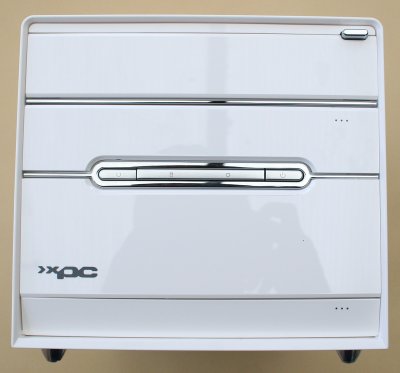External appearance

Based on Shuttle's G5 chassis design and presented in Apple white, the XPC SD11G5 is one of the better-looking SFF barebones units available. The minimalist look and clean lines, achieved by hiding the drives and ports behind push-down flaps, will appeal to the enthusiast that wants more than just a generic SFF box. The SD11G5 measures 280mm (l) x 200mm (w) x 185 (h), making it considerably smaller than, say, any Shuttle P-series chassis. Cooling any of the low-voltage S479 processors will be a relative doddle when compared to Intel's very own LGA775 hotties, so Shuttle should have no heat-related problems even with a small-ish chassis like this one.

Looking down past the 5.25" bay at the very top and the 3.5" in the middle, Shuttle arranges the usual series of ports and sockets behind another drop-down flap. Going from right to left, we have microphone and headphone ports that are followed by a couple of USB 2.0 ports and, finally, finished off with a 4-pin (host-powered) FireWire 400. The central section is home to the power and reset buttons that bookend hard drive and activity LEDs.

As is the norm with Shuttle XPCs, the aluminium cover is a one-piece affair that comes away by removing 3 holding thumbscrews at the back. Both sides have basic vents in the lower portions and a Shuttle embossing on each side.

Due to the comparatively narrow G5 chassis, Shuttle has chosen to locate audio and S/PDIF optical input and output jacks just above the regular I/O section, and the connections are part of an internal daughtercard. At the very top, there's cutouts for mounting an optional Parallel port and WiFi antenna, should you so wish. To the right, there's space for a single PCIe x1 card and a PCIe x16 graphics card. The 4 thumbscrews in the middle secure the I.C.E cooler to the back of the chassis.

Shuttle's opened up the connectivity options on the SD11G5 in fine style. There's, of course, the regular PS/2 ports that sit to the right of a single FireWire400 and Clear CMOS button; handy because you then don't need to open up the chassis if the BIOS needs resetting to its default state. You're able to connect onboard graphics (Intel GMA900) up via no less than 3 mediums. There's S-Video, VGA, and DVI connectors that, between them, have most of the output bases covered, and you can run both VGA and DVI concurrently and independently. Note that the DVI signal is digital and the connector will only work with displays that accept a digital input.
A couple of USB 2.0 ports sit below the RJ45 port that services the SD11G5's Gigabit Ethernet capability, and a 6-pin DC power inlet shows how Shuttle has been able to get away with designing a small chassis in the first place, as the passive 220W PSU is actually located externally. That's what you can get away with if running a low-wattage S479 CPU.









